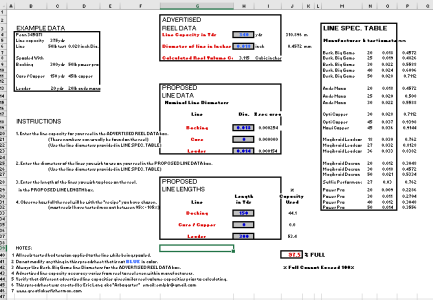simply use trigonometry

you have 2 sides of the triangle, the depth and the amount of line out by the chart, you can assume its a right angle triangle due to apex being at the tip of the rod. The 90 being where the diver meets the vertical being the depth. Now you have the offset of this triangle at an angle to your boat, you can break this up into 3 dimensional space and use vector math to solve that. I will go through an example with you and give you some quick multipliers to solve.
you can use Sine Law or Pythagorean Theorem to solve that
eg:
Diver is out 150' the chart says it is 45' down, how far is the diver away from my boat
Break the space up into X (direction from stern) Y (direction away from port or starboard) and Z (depth / vertical)
Solve the triangle that is made up of Z and is a partially between X and Y
Use Pythagorean Theorem to solve for this
Line Out^2 = Depth^2 + XY^2 rearrange and solve for XY
XY = 143
So now you know its away from the boat 143' however you do not know in what proportions to the back or the side.
At different speeds the angle of the plane that the line the depth and the xy falls on could be between 30 and 45 degrees
If the angle is 45 degrees you can use sin45 x 143
sin45 is 1/(2^(1/2)) or 1 over root 2 aka 0.707
Thus the diver would be 100' out to the side and 100' out to the back.
Suppose you were trolling slower and the angle was 30 degrees, now you would use sin30 which is 1/2 aka 0.5
you can solve for the distance away 143/2 = 71.5 to the side and then use Pythagorean theorem to solve the distance back or use Cos30 which is root 3 over 2 aka 0.866. So 0.866 * 143 = 124
Summary
Diver 150' out 45' down is between 70 and 100 ' to the side of your boat depending on your speed. My data shows the 30 deg (70' out) is relative to low 2 MPH and the 45 deg (100' out) is relative to around 3 MPH.
Hope thats clear as mud!






